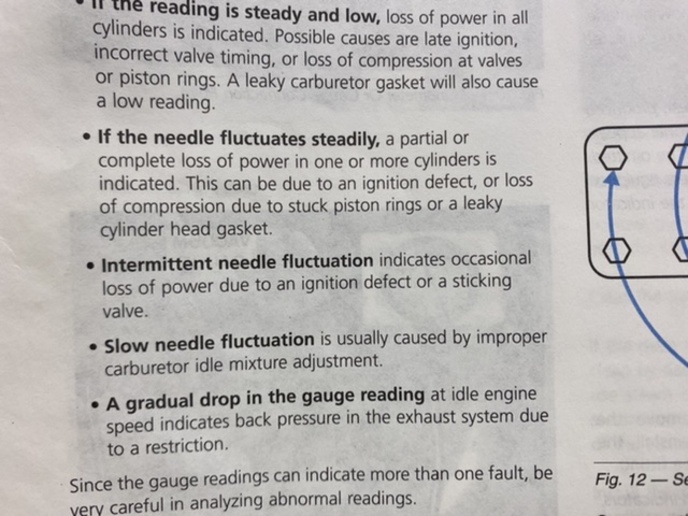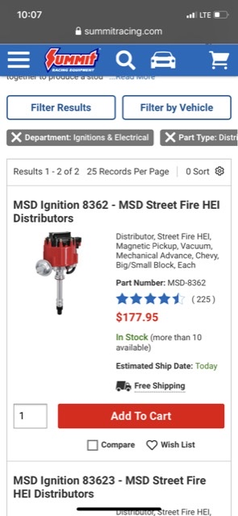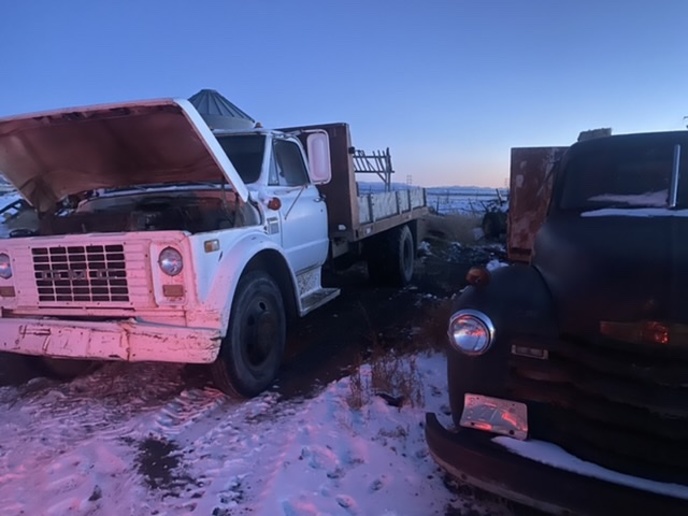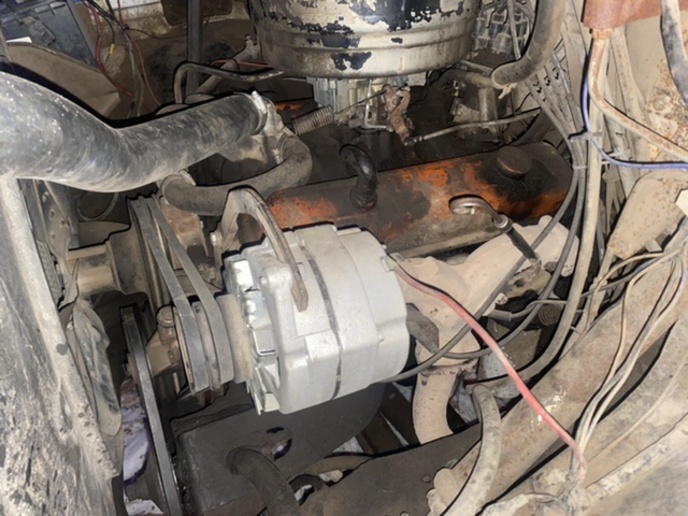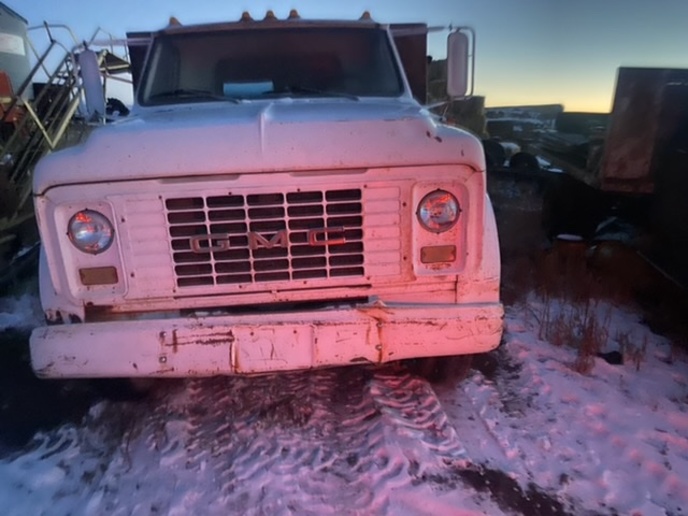You should upgrade or use an alternative browser.
- Thread starter SVcummins
- Start date
Steve@Advance
Well-known Member
Is there some problem you are having with it?
Any other symptoms?
used red MN
Well-known Member
- Location
- Coon Rapids, MN
idle it may increase the vacuum slightly. One you increase the rpm say over 2000 the vacuum actually decreases slight by a couple inches or so but holds relatively steady. I have a 99 3800 that runs okay and tried it on that one same result. In your case if you bring the engine up from idle with no load and you start at 20 in. then drop to 15 and keep going down I would say you have an restricted exhaust. What I see your gauge showing is a normal response. Could be a slight concern seeing the fluctuation. Not sure what that might indicate, maybe a valve train issue.
Easiest way to do that is line the crank pulley up with zero. Take the distributor cap off. Turn the engine backwards till the rotor just moves. Count the degrees on the timing indicator and you have the amount of slack in the timing chain.
used red MN
Well-known Member
- Location
- Coon Rapids, MN
wore out
Well-known Member
(quoted from post at 21:16:20 11/11/20) Just replace the distributor with a HEI. 1 wire hook up,new wires and plugs will be needed.
INTERESTING!
WHY would new sparkplugs be needed as park of the conversion to HEI?
rustred
Well-known Member
plus check your fuel pump for flow and pressure.
Steve@Advance
Well-known Member
1946 BN IHC
Member
Our chevy 350 in a p 30 van body modification to factory R.V. creca., 1983 has an electronic distributer; with maybe 10 to 12 mpg >>Thinking of converting it back to points distributer [ new off shelf designed for 1973 350 Chev] and re fitting the carb with leaner jets. All for hoping to reach 20 mpg. Would one of you mind writing me directly so we may discuss this via e mail.
Thank you.
Wm.
caterpillar guy
Well-known Member
Not moving tells me your gauge is sticking.
'72 350 should be running about 8 degrees timing.
Firing order 1-8-4-3-6-5-7-2
Point gap around .018 giving you the 30 degree dwell angle.
Set the dwell first, then set timing. Place an index mark at the base of the dist base.
If the mark does not move, neither does the dist in the future.
Reset your dwell back to 30 degrees and the timing will fall back in.
As long as your playing, Hold the timing light on the timing marks.
Does it bounce around at idle? Worn timing chain.
Rev engine about 1800
Do the timing marks bounce?
Worn dist shaft bushings.
[email protected]
Looking for higher mileage? GM Lean drop carb adj works well.
You are just gonna have to troubleshoot.
For the guy trying to gain mileage by changing carburetor and going back to points, that makes zero sense. I would put an aftermarket EFI with computer controlled timing if trying to make gains. There are kits out there, or can get the parts off a newer engine and put microsquirt on it. You would then have the opportunity to really tune it.
Indiana Ken
Well-known Member
With no load on the engine this is normal. If the vacuum dropped as the throttle was opened it would indicate a plugged exhaust system.
To have the manifold vacuum drop you have to open the throttle with the engine under load. For example, if you were traveling 50 MPH on a straight/level road the vacuum reading could be say 10". To maintain 50 MPH on a hill you would need to open the throttle which would cause the vacuum to drop. A drop in manifold vacuum indicates the increased load on the engine.
rustred
Well-known Member
timcasbolt
Well-known Member
doubt switching from HEI to a points distributor would have much effect, but if you do make sure you have the proper incoming voltage to the hot side of the coil. An HEI would have full voltage whereas a points system would likely have some sort of resistor, either with a ballast resistor or a steel wire coming from the ignition switch. Sticking a points distributor in a vehicle that came with HEI would cause the points to burn up very quickly.(quoted from post at 06:59:31 11/12/20) I would like to chime in with a question on Chev engine also.
Our chevy 350 in a p 30 van body modification to factory R.V. creca., 1983 has an electronic distributer; with maybe 10 to 12 mpg >>Thinking of converting it back to points distributer [ new off shelf designed for 1973 350 Chev] and re fitting the carb with leaner jets. All for hoping to reach 20 mpg. Would one of you mind writing me directly so we may discuss this via e mail.
Thank you.
Wm.
Robert (ID)
Member
Hdonly
Member
- Location
- Florida Panhandle
Hdonly
Member
- Location
- Florida Panhandle
I would too. Nothing wrong with points.
Destroked 450
Well-known Member
- Location
- Harned, Ky
Easy way to check the gauge is stomp on the gas pedal, the vacuum should momentarily drop to near zero and then come back up, if it doesn't the gauge is connected to a tank with a check valve to keep vacuum from bleeding back.
Something that wasn't been mentioned is the vacuum advance on the distributor, if the internal diaphragm goes bad it won't give the proper timing curve resulting in a retarded timing condition.
Jim.ME
Well-known Member
- Location
- central ME
(quoted from post at 23:10:09 11/13/20) 😀😀. I suppose I could cut the motor off and make it a dump trailer
Do some looking under the cab. behind the running board shields. Many of those had a vacuum tank and a frame mounted brake booster, split systems had 2 boosters. The gauge should be reading brake system vacuum.
Similar threads
- Replies
- 9
- Views
- 592
We sell tractor parts! We have the parts you need to repair your tractor - the right parts. Our low prices and years of research make us your best choice when you need parts. Shop Online Today.
Copyright © 1997-2024 Yesterday's Tractor Co.
All Rights Reserved. Reproduction of any part of this website, including design and content, without written permission is strictly prohibited. Trade Marks and Trade Names contained and used in this Website are those of others, and are used in this Website in a descriptive sense to refer to the products of others. Use of this Web site constitutes acceptance of our User Agreement and Privacy Policy TRADEMARK DISCLAIMER: Tradenames and Trademarks referred to within Yesterday's Tractor Co. products and within the Yesterday's Tractor Co. websites are the property of their respective trademark holders. None of these trademark holders are affiliated with Yesterday's Tractor Co., our products, or our website nor are we sponsored by them. John Deere and its logos are the registered trademarks of the John Deere Corporation. Agco, Agco Allis, White, Massey Ferguson and their logos are the registered trademarks of AGCO Corporation. Case, Case-IH, Farmall, International Harvester, New Holland and their logos are registered trademarks of CNH Global N.V.
Yesterday's Tractors - Antique Tractor Headquarters
Website Accessibility Policy


